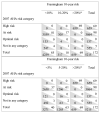Evaluation of the American Heart Association cardiovascular disease prevention guideline for women
- PMID: 20160160
- PMCID: PMC2841216
- DOI: 10.1161/CIRCOUTCOMES.108.842385
Evaluation of the American Heart Association cardiovascular disease prevention guideline for women
Abstract
Background: The 2007 update to the American Heart Association (AHA) guidelines for cardiovascular disease prevention in women recommend a simplified approach to risk stratification. We assigned Women's Health Initiative participants to risk categories as described in the guideline and evaluated clinical event rates within and between strata.
Methods and results: The Women's Health Initiative enrolled 161 808 women ages 50 to 79 years and followed them prospectively for 7.8 years (mean). Applying the 2007 AHA guideline categories, 11% of women were high risk, 72% at-risk, and 4% at optimal risk; 13% of women did not fall into any category, that is, lacked risk factors but did not adhere to a healthy lifestyle (moderate intensity exercise for 30 minute most days and <7% of calories from saturated fat). Among high risk, at-risk, and optimal risk women, rates of myocardial infarction/coronary death were 12.5%, 3.1%, and 1.1% per 10 years (P for trend <0.0001); the event rate was 1.3% among women who could not be categorized. We observed a graded relationship between risk category and cardiovascular event rates for white, black, Hispanic, and Asian women, although event rates differed among ethnic groups (P for interaction=0.002). The AHA guideline predicted coronary events with accuracy similar to current Framingham risk categories (area under receiver operating characteristic curve for Framingham risk, 0.665; for AHA risk, 0.664; P=0.94) but less well than proposed Framingham 10-year risk categories of <5%, 5% to 20%, and >20% (area under receiver operating characteristic curve for Framingham risk, 0.724; for AHA risk, 0.664; P<0.0001).
Conclusions: Risk stratification as proposed in the 2007 AHA guideline is simple, accessible to patients and providers, and identifies cardiovascular risk with accuracy similar to that of the current Framingham algorithm. Clinical Trial Registration- clinicaltrials.gov. Identifier: NCT00000611.
Figures

Comment in
-
The female heart is vulnerable to cardiovascular disease: emerging prevention evidence for women must inform emerging prevention strategies for women.Circ Cardiovasc Qual Outcomes. 2010 Mar;3(2):118-9. doi: 10.1161/CIRCOUTCOMES.110.942664. Circ Cardiovasc Qual Outcomes. 2010. PMID: 20233978 No abstract available.
References
-
- National Cholesterol Education Program (NCEP) Expert Panel on Detection, Evaluation, and Treatment of High Blood Cholesterol in Adults (Adult Treatment Panel III) Third Report of the National Cholesterol Education Program (NCEP) Expert Panel on Detection, Evaluation, and Treatment of High Blood Cholesterol in Adults (Adult Treatment panel III) final report. Circulation. 2002;106:3143–3421. - PubMed
-
- Grundy SM, Cleeman JI, Merz CN, Brewer HB, Jr, Clark LT, Hunninghake DB, Pasternak RC, Smith SC, Jr, Stone NJ, National Heart, Lung, and Blood Institute. American College of Cardiology Foundation. American Heart Association Implications of Recent Clinical Trials for the National Cholesterol Education Program Adult Treatment Panel III Guidelines. Circulation. 2004;110:227–239. - PubMed
-
- Wilson PWF, D'Agostino RB, Levy D, Belanger AM, Silbershatz H, Kannel WB. Prediction of Coronary Heart Disease Using Risk Factor Categories. Circulation. 1998;97:1837–1847. - PubMed
-
- D'Agostino RB, Grundy S, Sullivan LM, Wilson P, CHD Risk Prediction Group Validation of the Framingham Coronary Heart Disease Prediction Scores. Results of a Multiple Ethnic Groups Investigation. JAMA. 2001;286:180–187. - PubMed
-
- Lloyd-Jones DM, Wilson PW, Larson MG, Beiser A, Leip EP, D'Agostino RB, Levy D. Framingham risk score and prediction of lifetime risk for coronary heart disease. Am J Cardiol. 2004;94:20–24. - PubMed
Publication types
MeSH terms
Associated data
Grants and funding
- N01WH42129-32/WH/WHI NIH HHS/United States
- N01WH32100-2/WH/WHI NIH HHS/United States
- N01 WH022110/WH/WHI NIH HHS/United States
- N01WH32108-9/WH/WHI NIH HHS/United States
- N01WH32122/WH/WHI NIH HHS/United States
- N01WH32105-6/WH/WHI NIH HHS/United States
- N01WH32111-13/WH/WHI NIH HHS/United States
- N01WH32118-32119/WH/WHI NIH HHS/United States
- N01WH24152/WH/WHI NIH HHS/United States
- N01 WH042108/WH/WHI NIH HHS/United States
- N01WH42107-26/WH/WHI NIH HHS/United States
- N01WH32115/WH/WHI NIH HHS/United States
- N01WH44221/WH/WHI NIH HHS/United States
LinkOut - more resources
Full Text Sources
Medical

